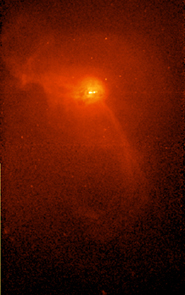May 10, 2004
CXC RELEASE: 04-04
Long-exposure images of the giant elliptical galaxy M87 by NASA's Chandra X-ray Observatory, together with radio observations, have provided spectacular evidence of repetitive outbursts from the vicinity of the galaxy's supermassive black hole. Magnetized rings, bubbles, plumes and jets ranging in size from a few thousand to a few hundred thousand light years point to ongoing violent activity for hundreds of millions of years.
"The hot X-ray emitting gas extending for hundreds of thousands of light years around M87 reveals a record of episodes of black hole activity," said Paul Nulsen of the Harvard-Smithsonian Center for Astrophysics (CfA) in Cambridge, Mass. and an author of an Astrophysical Journal paper describing the latest Chandra observations. "With these detailed observations, we are beginning to understand how the central supermassive black hole transfers enormous amounts of energy over vast reaches of space."
M87, located in the middle of the Virgo galaxy cluster, is surrounded by an extensive atmosphere of multi-million degree Celsius gas. Chandra's long-exposure image has allowed astronomers to see in more detail structures discovered by previous observations with Chandra and other X-ray telescopes, to discover new features, and to make specific comparisons with radio images, which trace the presence of high-energy electrons in a magnetic field."
The picture that emerges is one in which the infall of material toward a central supermassive black hole produces a magnetized jet of high-energy particles that blasts away from the vicinity of the black hole at near the speed of light. As a jet plows into the surrounding gas, a buoyant, magnetized bubble of high-energy particles is created, and an intense sound wave rushes ahead of the expanding bubble.
In Chandra's image of M87, X-rays from the jet dominate the central region of the galaxy. The jet is thought to be pointed at a small angle toward the line of sight, out of the plane of the image. Bright arcs around dark cavities of faint X-ray emission appear to be gas that has been swept up on rising, buoyant bubbles that were created a few million years ago (in M87 time - M87 is 50 million light years from Earth). These bubbles, which rise like hot air from a fire or explosion in the atmosphere, show up as bright regions in radio images. An alternative interpretation, presented in the June 1, 2004 issue of Astrophysical Journal Letters by Hua Feng of Tsinghau University in China and colleagues, is that the rings are shock waves that surround the jet and are seen in projection.
An image processed to bring out faint features reveals two circular rings with radii of 45 thousand and 55 thousand light years, respectively. These features are likely sound waves produced by earlier explosions about 10 million and 14 million years ago, respectively. A very faint arc at an even larger distance has a probable age of 100 million years.
Spectacular, curved X-ray plumes extending from the upper left to the lower right illustrate in dramatic fashion how the central black hole can affect the galaxy and its environment over huge distances. The arm on the upper left extends more than 75 thousand light years, and the one on the lower right more than 100 thousand light years from the center of the galaxy. These features are thought to be gas carried out from the center of the galaxy onbuoyant bubbles created by outbursts tens of millions of years ago.
A growing body of evidence from other galaxy clusters suggests that episodic outbursts from supermassive black holes in giant, centrally located galaxies are a common feature. These outbursts, which produce magnetized jets and bubbles of high energy particles, along with mammoth sound waves, could be due to the self-regulated inflow of gas into the black hole – gas around the black hole cools and flows inward to feed the black hole, producing an outburst which shuts down the inflow for a few million years, at which point the cycle begins again. Or, the cause could be a much more dramatic event, like the cannibalization of a smaller galaxy, with the subsequent merger of two supermassive black holes in the center.
The results from Nulsen's team, which included William Forman and other colleagues from the CfA, were based on approximately 40 hours of Chandra observations with its Advanced CCD Imaging Spectrometer. Andrew Young of the University of Maryland in College Park, and colleagues, have published a paper identifying many of the X-ray features in M87 in the November 10, 2002 issue of The Astrophysical Journal based on a shorter Chandra observation.
NASA's Marshall Space Flight Center, Huntsville, Ala., manages the Chandra program for the Office of Space Science, NASA Headquarters, Washington. Northrop Grumman of Redondo Beach, Calif., formerly TRW, Inc., was the prime development contractor for the observatory. The Smithsonian Astrophysical Observatory controls science and flight operations from the Chandra X-ray Center in Cambridge, Mass.
Additional information and images are available at:
MEDIA CONTACTS
Steve Roy
Marshall Space Flight Center, Huntsville, AL
Phone: 256-544-6535
Megan Watzke
Chandra X-ray Observatory Center, CFA, Cambridge, MA
Phone: 617-496-7998
cxcpress@cfa.harvard.edu





